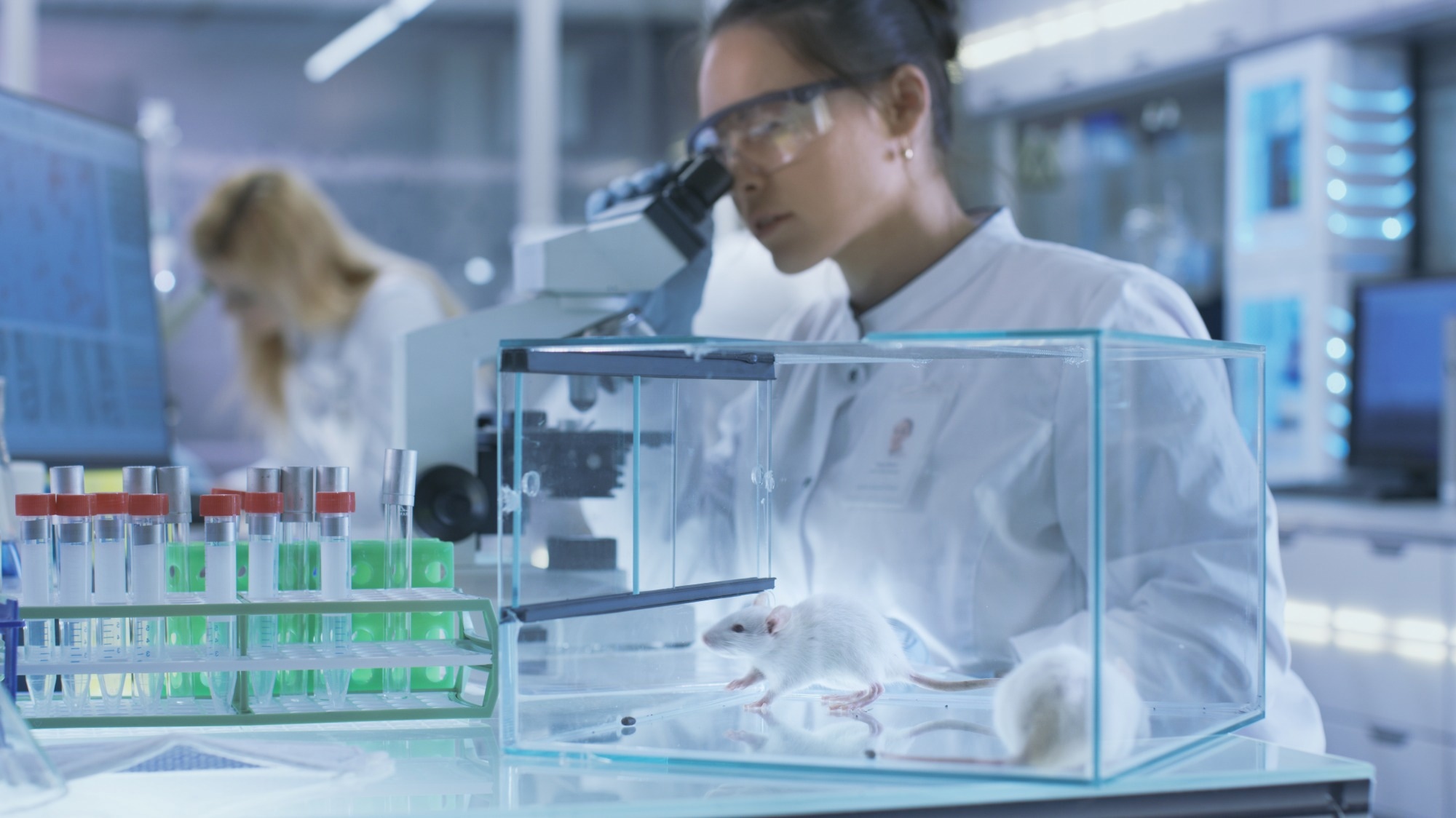In recent years, the ethical implications of animal testing in clinical research have sparked widespread debate and concern. This article delves into the promising rise of ethical alternatives in clinical research, shedding light on the innovative approaches that are shaping the future of medical experimentation.
 Image Credit: Gorodenkoff/Shutterstock.com
Image Credit: Gorodenkoff/Shutterstock.com
Ethical Alternatives in Clinical Research
Animal testing has a history that dates back to ancient times.1 The practice began as early as 500 BC, with records indicating that ancient Greek physician-scientists such as Aristotle, Herophilus, and Erasistratus performed experiments on living animals to explore the functions of organisms.1
The use of animals in scientific research continued, becoming more formalized and regulated in modern times.1 For instance, the United States passed the Animal Welfare Act (AWA) in 1966 to regulate animal testing; this has been amended several times to strengthen the welfare of animal subjects in research.1
Animal testing has played a crucial role in medical advancements. However, the practice has also been met with increasing ethical concerns and criticism, leading to a gradual decline in its use, driven by stricter regulations and a growing emphasis on alternative methods.1 For example, the Environmental Protection Agency's (EPA) plan to reduce and eventually eliminate mammal testing by 2035.1
Some of these alternative methods include in vitro culture of human cells and tissues, human pluripotent stem cells (hPSC) and human induce pluripotent stem cells (hiPSC)2, computational models3, organ-on-a-chip (OoCs)4 and 3D bioprinting5.
The Limitations and Ethical Concerns of Animal Testing
Animal testing faces several limitations that question its current relevance and effectiveness.
Animal models can show inefficacy in predicting human responses, this is partly because animals and humans can react differently to the same substances due to physiological differences.6 Animals are usually exposed to higher doses of compounds than humans would ever encounter, which can distort the outcomes and not accurately reflect human exposure levels.6
In drug development, more than 90% of identified compounds fail when tested in humans, indicating a poor translation from animal models to human biology.6 Additionally, test animals show shorter lifespan than human, limiting the study of chronic exposure to drugs.6
The last major limitation of animal testing is that it is extremely expensive, potentially killing thousands of animals, consuming time and resources, added to the ethical implications of animal experimentation.6
This ethical debate is the result of a series of specific concerns about animal suffering, their moral value as living creatures and their questionable need in research.7
It is known that approximately 20 million animals are used in experiments annually, with a significant portion not receiving painkillers, leading to suffering and a reduced quality of life.7 Critics of animal testing state that this could be a product of disrespect or lack of notion towards the intrinsic value of others living beings.7 Finally, the reproducibility to the human biology questions its applicability in real medical scenarios.7
Some of the organizations working against the use of experimental animals are People for the Ethical Treatment of Animals (PETA)8, the European Coalition to End Animal Experiments (ECEAE)9, and Humane Society International (HSI)10.
Advances in In Vitro and Computer-Based Models
In terms of in vitro models, hPSCs, including hiPSCs, are at the forefront of biomedical research. These cells have the ability to differentiate into a variety of cell types with the specific genetic makeup of the donor, making them incredibly valuable for modeling human disease, testing drugs, and exploring new treatments.11
hPSC and hiPSC have been used for modelling of a variety of diseases, such as neurodegenerative (e.g. Parkinson disease), metabolic and gastrointestinal disorders, cardiovascular and respiratory conditions, and the study of immune responses against pathogens like Mycobacterium tuberculosis and SARS-CoV-2.11
These models are fundamental for the development of organoids, a simplified versions of organs produced in vitro that show realistic micro-anatomy.12 Organoids derived from patient-specific hiPSCs have shown promise in biomedical research and preclinical drug testing12
With the advancement of technology, computer-based models have also emerged as promising alternatives to animal testing. Artificial intelligence (AI) is paving the way of these alternatives methods.13 AI creates and integrates computational models of human biology states (health/disease), and predict how new substances will affect it, without initial animal studies.13
Examples of these computational methods are the O’Hara-Rudy dynamic model, that has been used to develop action potential (AP) models from heart data, helping to predict drug-induced arrhythmias.13 The Virtual Assay software also uses in silico models based on human data to predict cardiac side effects of new drugs.14
Finally, the QSAR (Quantitative Structure–Activity Relationship) based computational approaches estimate the hazard potential of new compounds based on their similarity to known substances and human biology knowledge.13
 Image Credit: Gorodenkoff/Shutterstock.com
Image Credit: Gorodenkoff/Shutterstock.com
The Role of Human Organ Chips and 3D Bioprinting
The pursuit of alternatives to animal testing has also led to the development of human organ-on-a-chip and 3D bioprinting technologies.
An organ-on-a-chip is a miniaturized system that employs microengineering techniques to mimic the structure and functionality of human tissue.15 This innovative platform integrates areas of biomaterial technology, cell biology, and engineering.15 Successful developments have been made in creating organ models of the lungs, liver, kidneys, heart, intestines, and skin.15
With the same purpose, 3D bioprinting is an advanced technology that facilitates the 3D printing of a variety of cells, biocompatible materials, and supportive components, thereby enabling the creation of functional 3D tissues.16
The BRIGHTER project17 and the Clean Bioprinting18 initiatives seek to reduce animal testing by developing new 3D bioprinting processes for tissue engineering and creating in vitro models that substitute animal experimentation, especially in the cosmetic and pharmaceutical industry.
What is organ-on-a-chip technology?
The Impact and Future of Ethical Research Methods
Ethical considerations and scientific advances in research methods have led to a growing movement to replace animal testing with alternative approaches, or New Approach Methods (NAMs), which are not only more humane but also offer potential advantages in terms of cost, speed and relevance to human health outcomes.19
Regulatory agencies are beginning to adapt to the use of NAMs, although further validation and guidance are needed for widespread acceptance; the EU Reference Laboratory for Alternatives to Animal Testing (EURL-ECVAM) has been at the forefront of promoting non-animal methods.19
This shift toward ethical methods lies in the continued development and validation of NAMs, with the ultimate goal of eliminating animal testing.
Sources
- History of Animal Testing | ProCon.org. (2023). Animal Testing. [Online] https://shorturl.at/dfvN8
- Guhr A, et al. (2018). Recent Trends in Research with Human Pluripotent Stem Cells: Impact of Research and Use of Cell Lines in Experimental Research and Clinical Trials. Stem Cell Reports, 11(2), 485–496. https://doi.org/10.1016/j.stemcr.2018.06.012
- Pappalardo F, et al. (2018). In silico clinical trials: concepts and early adoptions. Briefings in Bioinformatics, 20(5), 1699–1708. https://doi.org/10.1093/bib/bby043
- Human Organs-on-Chips. (2023). Wyss Institute. https://wyss.harvard.edu/technology/human-organs-on-chips/
- Xia Z, et al. (2018. Tissue and Organ 3D Bioprinting. SLAS Technology, 23(4), 301–314. https://doi.org/10.1177/2472630318760515
- Stone, K. (2023). Limitations of Animal Tests. Humane Society International. [Online] https://shorturl.at/pwzJO
- Animal Testing and Ethics. (n.d.). [Online] https://shorturl.at/lNO35
- International Landing Page | PETA. (n.d.). [Online] https://www.peta.org/
- ECEAE. (n.d.). [Online] https://www.eceae.org/
- Humane Society International. (2024). Humane Society International. [Online] https://www.hsi.org/
- Aboul-Soud M. A. M, et al. (2021). Induced Pluripotent Stem Cells (iPSCs)—Roles in Regenerative Therapies, Disease Modelling and Drug Screening. Cells, 10(9), 2319. https://doi.org/10.3390/cells10092319
- Frum T, et al. (2020). hPSC-derived organoids: models of human development and disease. Journal of Molecular Medicine, 99(4), 463–473. https://doi.org/10.1007/s00109-020-01969-w
- Pérez Santín E, et al. (2021). Toxicity prediction based on artificial intelligence: A multidisciplinary overview. WIREs Computational Molecular Science, 11(5). https://doi.org/10.1002/wcms.1516
- About Virtual Assay v3 (Academic). (n.d.). [Online] https://process.innovation.ox.ac.uk/software/p/16245/virtualassay3_academic/1
- Singh D., et al. (2022). Journey of organ on a chip technology and its role in future healthcare scenario. Applied Surface Science Advances, 9, 100246. https://doi.org/10.1016/j.apsadv.2022.100246
- Ding Z, et al. (2023). Global hotspots and emerging trends in 3D bioprinting research. Frontiers in Bioengineering and Biotechnology, 11. https://doi.org/10.3389/fbioe.2023.1169893
- Everett H. (2022). 3D bioprinting project to deliver BRIGHTER alternative to animal testing. 3D Printing Industry. [Online] 3dprintingindustry.com/.../
- Berg, J, et al. (2020). Clean bioprinting - Fabrication of 3D organ models devoid of animal components. Alternatives to Animal Experimentation. https://doi.org/10.14573/altex.2009151
- On a 30-year mission to replace animal tests with alternative methods. (2021). EU Science Hub. [Online] https://shorturl.at/anpuE